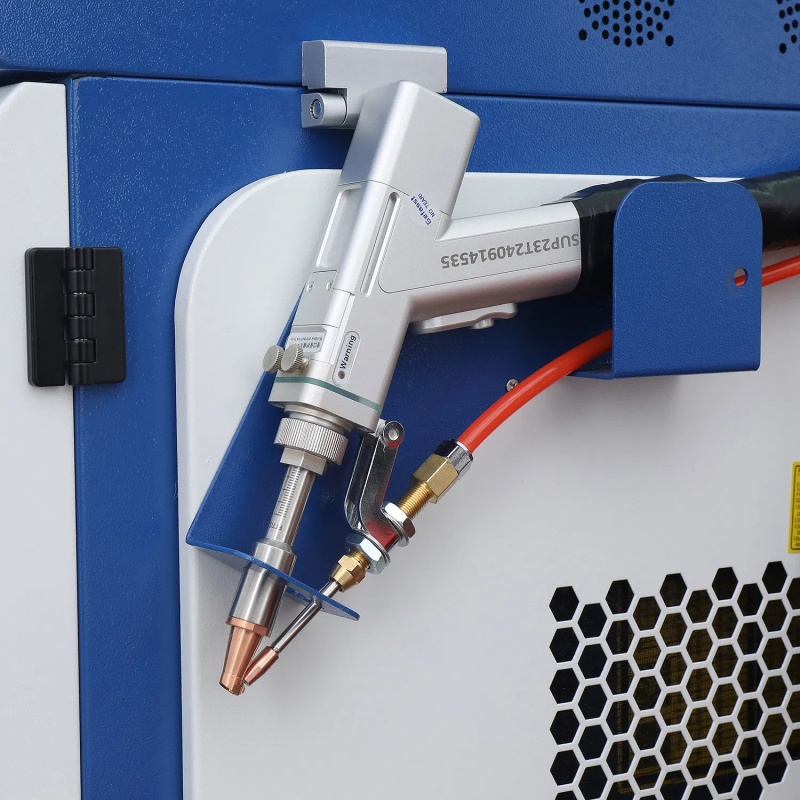In the vast landscape of modern industrial manufacturing, laser welding machines are like a shining star. With its excellent performance and unique advantages, they have become a key force in promoting the innovative development of various industries. It not only unlocks the infinite possibilities of multi-material welding, but also brings unprecedented changes and breakthroughs to many fields.
The working principle of the laser welding machine is based on a high-energy-density laser beam. When the laser beam is focused on the joint of the workpiece, the energy is released instantly, causing the material to quickly heat up to the melting point or even the boiling point. The material melts in a very short time and then cools and solidifies, thus achieving a firm connection. This process is like a magical “magic” in the microscopic world, accurately and efficiently fusing different materials together.
Compared with traditional welding methods, laser welding machines have many significant advantages. First of all, its welding accuracy is extremely high, and the weld width can be precisely controlled in a very small range, which can meet the welding needs of fine structures and complex-shaped workpieces. It plays an irreplaceable role in fields such as electronic components and medical devices that have almost demanding precision requirements. For example, when manufacturing precision medical devices such as pacemakers, laser welding machines can achieve micron-level welding, ensuring precise connection of tiny parts of the equipment and ensuring its safe and reliable operation.
Secondly, laser welding machines show good compatibility with a variety of materials. It can not only easily weld common metal materials such as carbon steel, stainless steel, aluminum alloy, copper and copper alloy, but also can be involved in the welding of non-metallic materials such as plastics and composite materials. More importantly, laser welding machines can achieve connection between dissimilar materials, which has opened up new paths for innovative applications of materials science and engineering. Taking automobile manufacturing as an example, connecting aluminum alloy with high-strength steel through laser welding can not only give play to the lightweight advantages of aluminum alloy, but also utilize the high toughness of high-strength steel to improve the overall performance of the car.

Furthermore, the heat-affected zone is extremely small during laser welding. Due to the high concentration of laser energy, the heat is quickly transferred and dissipated, and the thermal effect on the surrounding materials is minimal, which greatly reduces the deformation of the workpiece, especially suitable for welding thin plates or heat-sensitive materials. In the aerospace field, when manufacturing thin-walled structural parts such as aircraft wings, laser welding machines can minimize structural deformation while ensuring welding strength, ensuring that the aerodynamic performance of the aircraft is not affected.
In practical applications, laser welding machines have been widely penetrated into various industries. In the electronics industry, from tiny chip packaging to complex circuit board assembly, laser welding machines guarantee the performance and reliability of electronic products with their high precision and high speed. In the new energy industry, laser welding machines play a key role in the manufacture of power batteries. Whether it is the packaging of battery cells or the connection of modules, they require precise welding to ensure the safety and stability of batteries and provide solid support for the development of new energy vehicles. In the field of home appliance manufacturing, laser welding machines are used for welding the outer shells of refrigerators, washing machines, etc., which not only makes the welds beautiful and smooth, but also improves the durability of the products.
With the continuous advancement of science and technology, the development prospects of laser welding machines are even broader. On the one hand, its performance will continue to be optimized and improved, such as further improving welding speed, increasing welding depth, and expanding the types of weldable materials; on the other hand, the level of intelligence and automation will continue to improve. Through deep integration with artificial intelligence, big data and other technologies, intelligent monitoring and precise control of the welding process can be achieved, reducing labor costs, and improving production efficiency and product quality.
As an outstanding representative of modern welding technology, laser welding machines are helping various industries to make great strides on the road of innovation and development with their outstanding ability to unlock the possibilities of multi-material welding. It brings higher precision, stronger adaptability and better quality to industrial manufacturing, and has become the core force to promote industrial upgrading and technological innovation. It will surely create more brilliance and possibilities in the future.




